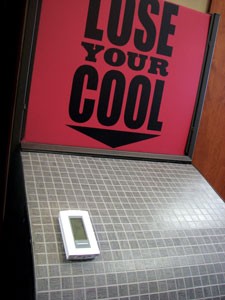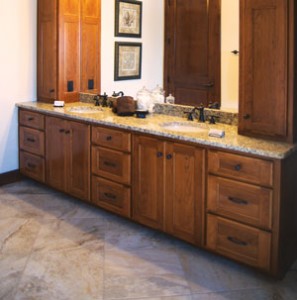Radiating heat
Flooring options fend off winter’s freeze
The jolt of bare toes making contact with a chilly floor can be a rude awakening on cold Wisconsin mornings. Whether it’s wood, tile or laminate flooring, these options are seemingly always cool to the touch, especially in frigid climates. Radiant or in-floor heating, however, can change that and warm your feet in the process.
“It’s something that’s gaining popularity,” says Janet Gunderson, design director at Home Interiors Flooring in Appleton. “We live in a very cold climate, of course, and people like the luxury of in-floor heating.”

Customers may experience the warmth of an electric mat at Home Interiors Flooring in Appleton. Photo by Julia Schnese
Gunderson notes that more customers are starting to notice radiant heat in their friends’ homes or Parade of Homes events.
“Once you have it, you like it and are familiar with it, and want more of it,” Gunderson adds of the products that help in creating overall comfort in a home. “It doesn’t seem like much, but when you’re stepping from a cold floor to a warm floor, you can definitely feel the difference.”
Areas of the home being targeted for radiant heat are master and basement baths, four-seasons rooms, kitchens, garages and workshop spaces. John Kramer, co-owner of Kramer Peterson Heating & Cooling Inc. in Appleton, also recommends the flooring option for homes on concrete slabs, condos, residences without a basement and assisted living facilities.
“Older people like it because it’s a constant heat and warmer heat,” Kramer notes. “It’s nice to have the warmer heat on the floors.”
In-floor heating is typically used under ceramic tile and other hard surfaces. While some products can be used under carpet, it is seldom done since carpet is usually warm enough on its own and there are concerns with trapping heat under a dense pad, which can create a fire hazard. In-floor heating also cannot have heavy, big rugs over the top of it or be installed under cabinets, explains Barb Skubal, interior design at Total Floor Covering in Appleton. Some adhesives can be a concern as well. The flooring products can, however, be installed pretty much anywhere.
“Some people will do it throughout the whole house,” says Kramer. “Once it heats up, it stays warm all the time.”
Kramer has installed a hot water coil system in his revamped Appleton business workspace that heats the whole shop and combats the concrete floor. He sets the boiler between 58 and 60 degrees.
“Once it stays hot, it radiates out so it may go up a few degrees,” he notes.
There are different types of in-floor heating options available — hot water coil, electric coil and electric mat. The mat systems are designed for smaller, exact square or rectangular spaces, says Skubal. The mats come in predetermined sizes whereas the coil systems are more flexible. Because of the restrictive sizes of the mats, they may not be the most efficient option for a space.
Flooring options come with a programmable thermostat that connects to a probe under the surface. An electrician is needed to put in the thermostat and install the flooring properly.
“Most people set them once and then forget about them,” says Gunderson.
“It can go on at 5 in the morning, stay on for a couple of hours and then turn off,” adds Skubal.
It is important, however, to make sure that the temperature is set within a proper range.
Concrete can turn to powder if the water is too hot in a hot water coil system, says Kramer. “Different floor sources need different temperatures,” he notes.
This is not a project for do-it-yourself homeowners.
“You could have a very expensive mistake on your hands,” shares Gunderson.

Master baths are popular rooms for radiant heat like this project by Total Floor Covering. Photo courtesy of Steckling Builders LLC
“The ordinary person can’t just hook this up,” echoes Kramer. In a hot water coil system, the tubes are laid closer together toward the outside wall to prevent heat loss and spaced out near the interior of the room. The tubes also are run through a pressure test to check for air leaks and temperature changes, shares Kramer.
“If it stops working, the whole floor has to come out,” stresses Skubal. “It really is important to have a professional installer and electrician involved. … There’s a lot of do-it-yourselfers, bless their hearts for trying it, but it’s not easily coming back out.”
In addition to testing the system prior to covering it with concrete, it also needs to be insulated properly. And, because there is water in the tubes with a hot water coil or boiler system, glycol or antifreeze needs to be injected to keep the tubes from freezing. Once concrete is poured, expansion cuts also need to made in it to prevent cracking over time. The heat source, burners and pumps for radiant heat should receive a cleaning and tune-up annually as you would do with a furnace. Most systems have a 20-year or lifetime warranty, Kramer notes.
“They can only guarantee the product if it’s installed correctly,” Skubal adds.
Radiant heat also can be used as an auxiliary heat source with traditional heat, Gunderson says. She encourages clients to do their homework when considering radiant heat for their home since not all products are created equal.
“Sometimes people get sticker shock when they look at the price of this product, but it is a long-term investment,” she says. Different pricing and flooring options are available with each seller.
— FC










Leave a Comment